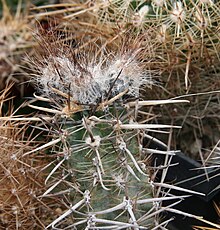Austrocactus
| Austrocactus | ||||||||||||
|---|---|---|---|---|---|---|---|---|---|---|---|---|

Austrocactus spec. |
||||||||||||
| Systematics | ||||||||||||
|
||||||||||||
| Scientific name | ||||||||||||
| Austrocactus | ||||||||||||
| Britton & Rose |
Austrocactus is a genus of plants fromthe cactus family (Cactaceae). The botanical name is derived from the Latin noun oyster for south and refers to the southern origin of the plants.
description
The individual or branched, soft-fleshed, spherical to short-cylindrical plant bodies reach heights of growth of 30 to 60 centimeters and diameters of up to 8 centimeters. On them there are 6 to 12 ribs, some of which are humped. The hooked or straight central spines and the needle-like radial spines arise from the areoles .
The funnel-shaped, bristle-thorned flowers appear near the apex, become 3 to 6 centimeters long and open during the day. The wide, inverted conical flower cup and the short flower tube are covered with reduced scales and tufts of woolly hair. The scars are more or less purple or pale yellow. The stamens are arranged in two circles.
The spherical to oblong, greenish fruits are covered with wool and bristles. They have a persistent flower remnant, burst unevenly or at the base and contain black to brown, wrinkled, oval seeds that are 2 to 2.5 millimeters long.
distribution
The genus Austrocactus is native to the western and southern parts of Argentina in the provinces of Neuquén , Rio Negro Chubut and Santa Cruz and in central and southern Chile in the Andes in the Región del Maule and in the Región Metropolitana (Mina Las Arañas).
Systematics
The type species of the genus is Cereus bertinii . The following species belong to the genus Austrocactus :
- Austrocactus bertinii (Cels ex Hérincq) Britton & Rose
- Austrocactus colloncurensis I. Schaub & Keim
- Austrocactus coxii (K.Schum.) Backeb.
- Austrocactus ferrarii R. Kiesling, E. Sarnes & N.Sarnes
- Austrocactus patagonicus (FACWeber ex Speg.) Hosseus ex Backeb.
- Austrocactus philippii (Rule) Buxb. & F.Ritter
- Austrocactus spiniflorus (Phil.) F.Ritter
Austrocactus is very closely related to the genus Corryocactus .
Botanical history
The first plants were discovered in 1855 by E. Cels, a brother of Jean-François Cels (1771-1832), on the coast of Argentina at 45 ° 30 'south latitude. However, the plants did not survive the transport to Europe. In 1861, Captain Pierre Bertin (1800–1891) collected new plants at the site. These later flourished with Jean-François Cels, who in 1863 also published the first description as Cereus bertinii .
Nathaniel Lord Britton and Joseph Nelson Rose put Cereus bertinii in 1922 under the name Austrocactus bertinii as the only species in the genus Austrocactus they created , which was monotypical for four years . The second species followed in 1926, the recombination of Cereus patagonicus as Austrocactus patagonicus , which Carl Curt Hosseus (1878–1950) made.
proof
literature
- Edward F. Anderson : The Great Cactus Lexicon . Eugen Ulmer KG, Stuttgart 2005, ISBN 3-8001-4573-1 , p. 83-85 .
- Curt Backeberg : Die Cactaceae: Handbuch der Kakteenkunde . 2nd Edition. tape III . Gustav Fischer Verlag, Stuttgart New York 1983, ISBN 3-437-30382-1 , p. 1557-1563 .
- Walther Haage : cacti from A to Z . 3. Edition. Quelle & Meyer Verlag, Heidelberg 1986, ISBN 3-494-01142-7 , p. 29 .
Individual evidence
- ^ Edward F. Anderson : The great cactus lexicon . Eugen Ulmer KG, Stuttgart 2005, ISBN 3-8001-4573-1 , p. 84-85 .
- ↑ Ingrid Schaub, Ricardo Keim: A new species from Argentina - Austrocactus colloncurensis (Cactaceae) . In: Cacti and other succulents . Volume 65, Number 8, 2014, pp. 211-216.
- ^ Elisabeth Sarnes, Norbert Sarnes, Roberto Kiesling: Austrocactus ferrarii (Cactaceae) - the northernmost representative of the genus Austrocactus . In: Cacti and other succulents . Volume 63, Number 12, 2012, pp. 327-333.
- ^ Curt Backeberg: Die Cactaceae: Handbuch der Kakteenkunde . 2nd edition, 1984, Volume III, pp. 1558f.
- ^ In: François Hérincq: Horticulteurs Francais; Journal des Amateurs et des Interets Horticoles . Series 2, Volume 5, Paris 1863, p. 251.
- ^ NL Britton , JN Rose : The Cactaceae. Descriptions and Illustrations of Plants of the Cactus Family . tape III . The Carnegie Institution of Washington, Washington 1922, p. 44-45 ( online ).
- ^ Revista del Centro Estudiantes de Farmacia . Volume 2, No. 6, Córdoba 1926, p. 24.
